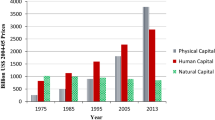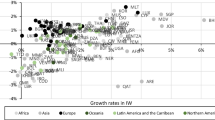Abstract
This paper explores the consequences of changes in a system’s resilience on the sustainability of resource allocation decisions, as measured by Inclusive Wealth (IW) (Arrow et al. in Environ Resour Econ 26:647–685, 2003). We incorporate an estimate of resilience in IW by taking account of known or suspected thresholds that can lead to irreversible (or practically irreversible) changes in the productivity and value of assets and hence social welfare. These thresholds allow us to identify policies or projects that may be leading to an increased risk of decline in capital stocks (the wealth of the region). Such risks are not reflected through usual measures of current system performance, e.g. agricultural production. We use the Goulburn-Broken Catchment in south-eastern Australia as a case study to explore the significance and practicality of including resilience in inclusive wealth estimates.
Similar content being viewed by others
References
Anderies JM, Ryan P, Walker BH (2006) Loss of resilience, crisis and institutional change: lessons from an intensive agricultural system in southeastern Australia. Ecosystems 9: 865–878
ABS (1998) Agriculture, Australian Bureau of Statistics
ABS (2001) Agriculture, Australian Bureau of Statistics
Andren H (1994) Effects of habitat fragmentation on birds and mammals in landscapes with different proportions of suitable habitat: a review. Oikos 71: 355–366
Arrow KJ, Dasgupta P, Maler K-G (2003) Evaluating projects and assessing sustainable development in imperfect economies. Environ Resour Econ 26: 647–685
Arrow K, Dasgupta P, Goulder L, Daily G, Ehrlich P, Heal G, Levin S, Maler KG, Schneider S, Starrett D, Walker B (2004) Are we consuming too much?’. J Econ Perspect 18(3): 147–172
Arrow KJ, Fisher AC (1974) Environmental preservation, uncertainty, and irreversibility. Q J Econ 88(2): 312–319
Biggs R, Pearson L, Harris M, Walker B (2009) Measuring sustainable development: a pilot implementation of inclusive wealth in the Goulburn-Broken Catchment, Australia
Bennett A, Ford L (1997) Land use, habitat change and the distribution of birds in fragmented rural environments: a landscape perspective from the Northern Plains, Victoria, Australia. Pac Conserv Biol 3: 244–261
Bishop R (1978) Endangered species and uncertainty: the economics of a safe minimum standard. Am J Agric Econ 60(1): 10–18
Ciriacy-Wantrup S (1952) Resource conservation. University of California Press, Berkeley
Dasgupta P (2008) Nature in economics. Environ Resour Econ 39(1): 1–54
Dasgupta P, Maler K-G (2001) Wealth as a criterion for sustainable development. World Econ 2(3): 19–44
Dasgupta P, Maler K-G (2003) The economics of non-convex ecosystems. Environ Resour Econ 26(4): 499–685
Harris M, Fraser I (2002) Natural resource accounting in theory and practice: a critical assessment. Aust J Agric Resour Econ 46(2): 139–192
Henry C (1974) Investment decisions under uncertainty: the irreversibility effect. Am Econ Rev 64((5): 1006–1012
Holling CS (1973) Resilience and stability of ecological systems. Annu Rev Ecol Syst 4: 1–23
Maler K-G, Li CZ, Destouni G (2007) Pricing resilience in a dynamic economy-environment system: a capital-theorethical approach. Beijer Discussion Papers 208, the Royal Swedish Academy of Sciences
Maler K-G (2008) Sustainable development and resilience in ecosystems. Environ Resour Econ 39: 17–24
Narain U, Hanemann M, Fisher A (2007) The irreversibility effect in environmental decision making. Environ Resour Econ 38: 391–405
Norton B (1995) Resilience and options. Ecol Econ 15: 133–136
Perrings C (1998) Resilience in the dynamics of economy-environment systems. Environ Resour Econ 11(3–4): 503–520
Perrings C, Walker B (1997) Biodiversity, resilience and the control of ecological-economic systems: the case of fire-driven rangelands. Ecol Econ 22: 73–83
Perrings C, Stern D (2000) Modelling loss of resilience in agroecosystems: rangelands in Botswana. Environ Resour Econ 16: 185–210
Scheffer M et al. (2001) Catastrophic shifts in ecosystems. Nature 413: 591–596
Serrão EAS et al. (1996) Upland agricultural and forestry development in the Amazon: sustainability, criticality and resilience. Ecol Econ 18: 3–13
Smith V, Krutilla JV (1979) Endangered species, irreversibilities, and uncertainty: a comment. Am J Agric Econ 61(2): 371–375
Trosper RL (2002) Northwest coast indigenous institutions that supported resilience and sustainability. Ecol Econ 41: 329–344
Walker B et al (2004) Resilience, adaptability and transformability in social–ecological systems. Ecol Soc 9(2): 5. [online] URL: http://www.ecologyandsociety.org/vol9/iss2/art5
Walker B, Meyers JA (2004) Thresholds in ecological and social-ecological systems: a developing database. Ecol Soc 9(2): 3. [online] URL: http://www.ecologyandsociety.org/vol9/iss2/art3
Walker B, Pearson L, Harris H et al (2007) Incorporating resilience in the assessment of inclusive wealth: an example from South East Australia, Beijer Discussion Papers 209, the Royal Swedish Academy of Sciences
Whish-Wilson P, Shafron W (1997) Loddon and Campaspe catchments: costs of salinity and high watertables to farms and other businesses. ABARE, Canberra
Author information
Authors and Affiliations
Corresponding author
Rights and permissions
About this article
Cite this article
Walker, B., Pearson, L., Harris, M. et al. Incorporating Resilience in the Assessment of Inclusive Wealth: An Example from South East Australia. Environ Resource Econ 45, 183–202 (2010). https://doi.org/10.1007/s10640-009-9311-7
Received:
Accepted:
Published:
Issue Date:
DOI: https://doi.org/10.1007/s10640-009-9311-7




